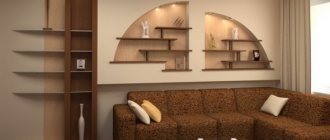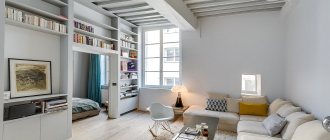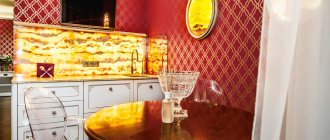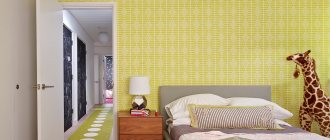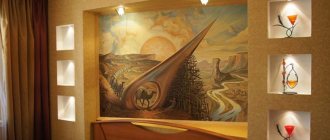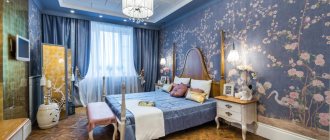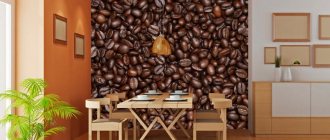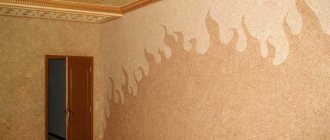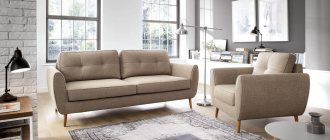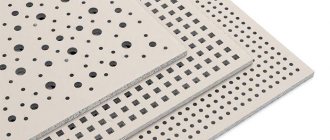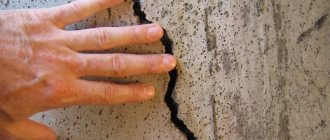Types of television niches
There are several varieties.
In furniture
Spacious cabinets with drawers, cabinets, walls, chests of drawers and other built-in cabinet furniture with a recess for a TV device are not only a very impressive, but also a functional interior solution that has a full-fledged appearance.
In the wall
A niche in the wall is considered a fairly modern design, allowing you to competently organize the TV space and compactly arrange all the necessary devices, for example, an entire home theater.
Partition
With the help of this technique, it is possible to visually change the interior perception and thereby relieve the design of the room from monotony and severity. In addition, a partition can be a very practical solution for a small one-room apartment in a Khrushchev-type building.
Making a plasterboard box
First you need to decide on the size of the niche, and also think about where it will be located. In addition, you must first carry out the electrical work. The cord must be routed into the inside of the box for installing sockets. Since the front part of the box will be lined with laminate, the width can be calculated so that the laminate does not have to be cut lengthwise. The length of the entire niche is the size of two strips of laminate, so as not to cut it across. The size of the niche is calculated exclusively for the size of the TV. Therefore, before you start assembling the box, it is important to already know which TV will be fixed inside. The thickness of the niche also depends on the thickness of the TV.
Assembly begins with the contours of the niche. To do this, you can use a UD metal profile, which is attached to the wall with self-tapping screws.
When installing the profile, it is important to adhere to a horizontal level. Next is a partition for a TV with a horizontal profile fastening.
The size of the internal niche for the TV should be 1 - 1.5 cm larger than the TV itself, so that there is a gap between them. After you have drawn the outline of the entire niche, you can begin installing the box itself. To do this, use a CD profile 10 cm long. Insert it into the groove of the UD profile with an indentation of 30 - 40 cm. On the reverse side, also fix the UD profile strip. The profile is attached to each other using LM metal screws.
On the right side of the box, two CD profiles must be fixed vertically for rigidity. After this, you can cover the sides of the niche with plasterboard. On the front side, the drywall should protrude 5 cm on all sides, and not be flush with the profile.
If you wish, you can later attach an LED strip behind the protruding drywall. On the right side, you can completely cover the box with plasterboard, or screw sections to the profile to save money.
At this point, it would be wise to hang up the TV mount and double-check that you haven't gotten the dimensions wrong. You can hang the TV to make sure it fits well into the inner box. This will also allow you to determine the exact location to install the outlets.
The next stage is lining the niche with laminate. Of course, natural wood will look rich and beautiful, but a simpler and more economical option is laminate. You can fasten the laminate using liquid nails, applying glue with a syringe to the laminate or directly to the frame.
The bottom strip is attached first. The locks must first be cut off from the side parts of the right and left laminate strips. You will need a jigsaw to trim the left side of the niche. Use clamps to securely secure the laminate to the drywall. You should not begin installing the next strips until the first bottom strip is securely fastened.
As a rule, liquid nails set quickly, so you will have to wait 15 - 20 minutes. Then you can add the laminate further.
On all laminate strips, the side seams on the left and right must be cut. When installing the top two strips of laminate, you must first cut off the top lock from them, and also secure them with clamps.
To hide the uneven cut corners of the laminate, you can also use liquid nails to fix a decorative corner to match the tone of the laminate. To fix the corner until it sticks together, use tape.
Next, in the inner part of the niche, you can putty the surface and glue the same wallpaper there as around the entire structure. It is also necessary to secure the sockets and the TV mount at a level. Then you can glue LED strip along the edges of the box on all sides. The final stage of work is fixing the TV in the mount.
Niche design options
When creatively designing this recess, it should not only have a stylish and original appearance, but also not conflict with the overall decor.
From plasterboard
A niche made of gypsum plasterboard has a truly attractive and fashionable appearance and allows you to give the space some volume. In addition, gypsum board does not require large expenditures, is quite easy to use and is durable, which ensures safety for the TV device.
The photo shows the kitchen interior and a plasterboard niche with a curved TV, decorated with a frame made of moldings.
With the help of elastic plasterboard, you can implement all kinds of design solutions and construct various decorative niches that give the interior a special uniqueness.
The photo shows a plasterboard niche for a TV in the interior of a children's room.
From laminate
Eco-friendliness and natural motifs are the latest trend in room decoration. Thanks to a laminate that imitates the natural color of wood, it is possible to achieve a more intricate and interesting design for the recess with a plasma TV.
From stone
Decorative stonework is a natural object with an inimitable texture that becomes a wonderful addition to any design. This finish allows you to add a certain rigor and reliability to the interior.
Made of wood
A wooden niche is a universal decorative find, which, due to its beauty and environmental friendliness, gives the atmosphere unobtrusive expressiveness.
The photo shows a TV in a niche with wooden trim in the interior of a modern bedroom.
Brick
Such stylish interior decoration allows you to create interesting accents in the room and, depending on its original or painted appearance, give the atmosphere brutality or relaxed naturalness.
The photo shows a kitchen interior in light colors and a TV in a narrow niche lined with white brick.
Wallpaper
By decorating a niche with the same wallpaper that covers the entire room, you can harmoniously combine the TV area with the entire interior and make it an integral part of the overall design.
The photo shows a square niche for a TV, decorated with wallpaper in the living room interior.
Why do you need a niche?
You can simply put a bedside table for the TV or hang it on the wall. Why fool yourself with creating a huge structure, providing special niches in it? There are several reasons for this.
- It’s good to hide not only the TV in a niche, but also speakers and wires. In this case, small children will not have access to them, and it’s even more beautiful this way.
- When a TV stand is made from plasterboard, it seems bulky and alien to the room. In the case of a niche, the TV becomes part of the interior.
- In the created niches you can create hidden lighting, which will make the room more beautiful, and spending time in the evening watching TV will become more enjoyable.
- Niche shelves can be used to place other items (books, CDs, etc.).
Shapes and sizes of niches for TV
The choice of shape and size primarily depends on the characteristics of the room being designed and its style.
- Corner. It does not clutter up the space and allows you to rationally use the corner, which is especially suitable for a small room.
- Rotary. It is quite an expressive interior accent and, due to the rotating system, makes it very convenient to use.
- Under the stairs. A niche well-fitted into the space can take a central place in the design of the room, relegate the staircase to the background and make the structure less cumbersome.
- The entire wall. With the help of a recess across the entire wall, it is possible to effectively fill the space. However, this decorative technique is more appropriate for spacious rooms.
- Rounded. A round or semicircular shape significantly softens the atmosphere, smoothes and ennobles the architectural rectangularity of the space.
The photo shows a rounded niche for a TV in the shape of an arch in the interior.
The size and shape of this design not only add variety and expressiveness to the environment, but also have a very important meaning on which the visual perception of the room’s configuration depends.
Assembling the frame - step-by-step instructions
- We cut all profiles to the required size. Usually they take 27*28 mm guides. They are attached to the surface and are also used as jumpers. Rack profiles 60*27 mm are required to create a supporting frame. Please note that the profile sizes are chosen to match each other.
- A guide profile is attached to dowels along all marked surfaces (both vertically and horizontally) (attachment pitch 40 cm). The guides are also attached to the floor and ceiling (if required by the selected form of the structure). On the floor, the profile is attached perpendicular to the wall and a vertically installed guide. They do the same on the ceiling.
- More guides are laid between the profiles on the floor. If necessary, do the same on the ceiling. A niche for a TV made of plasterboard implies the presence of a recess, which is created by such installation of profiles.
- We insert the rack profile into all places where it is necessary according to the sketch.
- Between the racks, jumpers made of guides are attached, which will serve as the upper and lower parts of the niches being created. These jumpers must be parallel to the horizontal guides that were installed on the floor.
- A rack profile is installed vertically between the jumpers and the lower guides. This creates a kind of plasterboard box for a TV.
- If necessary, the structure can be strengthened with additional jumpers. Usually they are installed for the plane on which the TV will be placed.
When constructing a niche frame, it is important to strengthen those places where the greatest load is expected.
All profiles must be connected to each other using “bugs”. These are small screws for metal. You can also use a cutter, but not everyone knows how to choose and work with it correctly.
All TV niche jumpers must be fixed with self-tapping screws, as additional load will be placed on them.
Design ideas around the TV
Design options for the area around the TV device.
With shelves
A variety of shelves are a very common decor option. They can be decorated with books, photo frames, decorated with flower arrangements, figurines, or various equipment can be conveniently placed on them.
TV and fireplace
A TV in a niche, in combination with an electric fireplace, bio-fireplace or false fireplace, looks very beautiful, sets the right mood for the interior of an apartment, country house or cottage and makes the atmosphere much more comfortable and cozy.
Backlit
Thanks to well-placed additional lighting, the space not only becomes much brighter and lighter, but also noticeably transforms. In addition, the backlight favorably highlights and focuses attention on the TV screen.
With stucco
This decor gives the design special respectability and aristocracy. Plasma, recessed in stucco patterns, will become an incredibly presentable element of the room.
The photo shows a living room in the Art Nouveau style with a TV located in a niche decorated with stucco.
With speakers
Such a recess not only represents the center of the whole composition and is a full-fledged design element, but also provides the opportunity to hide wires and harmoniously fit speakers and all the necessary equipment into the space, without destroying its visual component.
Aquarium
Adds individual character to the environment and becomes a real living picture, giving the final aesthetic touch to the entire design.
Making a niche for a TV from gypsum plasterboard with your own hands
To make a beautiful portal for a TV you need to prepare:
- aluminum profile CW (ceiling wall) and UW (guide), for arched elements - flexible; — accessories — fasteners, pendants, extensions, corners; — connectors (screws for GPB and profile, dowels); — Drywall — standard, if necessary — arched; — Plasterboard base and putty; - Sealing tape for joints, joints and internal corners; - Decoration Materials.
Tools needed: hammer drill (for drilling holes in the wall), spirit level (preferably laser), screwdriver, drywall cutter, scissors or hacksaw, drywall sandpaper, carpet, putty knife, finishing roller. .
First, you need to decide on the design of the future niche. It can be protruding, with open corners or recessed. In the second option, you will have to cover most of the wall with plasterboard, but this will make the interior more thoughtful and stylish.
Depending on the shape, there are rectangular horizontal, rectangular vertical, square, oval, curved and complex patterns. Standard rules apply: upward lines visually lift the ceiling, while lines parallel to the floor allow you to expand a narrow wall. The unusual geometry is suitable for both rooms with a non-standard layout and large rooms.
Additional shelves are often placed around the TV to accommodate stereo equipment, jewelry, and books. If you wish, you can even make a whole rack or cabinets from plasterboard, which next to the niche will look like one whole.
The assembly of the structure is carried out in stages. First, the wall is marked with a laser level and tape measure, and then a metal frame is built according to the drawing. The depth of the niche should be calculated based on the thickness of the TV, adding 5-7 cm for the gap for wiring and ventilation. Free space between the wall and the screen is necessary for air circulation and cooling of devices. They also usually leave space around the monitor - firstly, to make it easier to hang and remove, and secondly, after a while you may want to buy a model with a larger diagonal.
Before you begin, you need to decide where the electrical wiring will be hidden - it can be lined or hidden inside plastic duct skirting boards.
First, the guide profile is mounted, with the pegs placed at a distance of no more than 40 cm from each other. Then vertical elements are attached to the ceiling and floor. The base of a small recess can also be made separately and then mounted on the wall.
The next step is to cover the frame with plasterboard, previously cut to the appropriate shape. You should start with small and complex elements. Self-tapping screws are used as fasteners, the pitch between them is 25-30 cm.
After the drywall is laid, it is leveled with putty and primed. Seams and joints are reinforced with corrugated tape, and the outer edges are covered with perforated metal corners. Putty is applied to the top layer of primer, and after sanding, the finishing layer is applied.
Photos of beautiful niches in the interior of rooms
Options for original design in various rooms.
Bedroom
To decorate a niche with a TV in the bedroom, they prefer lighter and more delicate shades that do not visually overload the space, for example, beige, soft pink or white. In most cases, this room is not large in size, so medium or small recesses are appropriate here. Also, to save space, compact LCD models with a small diagonal, built into storage systems, are suitable.
Living room
This solution will give the living room special dynamism, liveliness and interest. The TV recess can have either a bright and contrasting color design or be made to match the main color palette of the room’s wall decoration.
In a more spacious room, it would be appropriate to decorate a niche with different textured materials, such as relief tiles, decorative stone and brick, wood, chipboard, laminate, mirror, decorative plaster and much more. To further highlight and focus attention on the non-through opening with the TV panel, it is possible to use baguettes, moldings or original lighting, which gives the architectural composition special exclusivity.
The photo shows a plasterboard niche for a TV in a living room interior in light colors.
Kitchen
The kitchen space or dining room primarily involves compact and functional recesses finished in the form of decorative stone, wood, glass, wallpaper and other materials or niches located in various pieces of furniture, for example, in a kitchen set or buffet.
The photo shows a kitchen with a TV in a niche located in a white kitchen unit.
Portal in the living room
A living room with a niche for a TV is an opportunity to arrange the room in a modern way. After all, you can build a wall around the TV screen with the compartments you need. Interesting lighting, exclusive decorative elements and works of art help make the design original. In addition to paintings, you can put elegant figurines on the wall.
A plasterboard niche requires less space when compared to standard pieces of furniture - cabinets or shelving. In addition, the gypsum board construction looks more stylish. It is truly unique: you can’t buy one like this in a store.
The design is successfully used for zoning a room as an internal partition. It partially replaces furniture, allowing you to save useful space. If you are making shelves for books, then it is better to take boards. Wood or glass can withstand significant loads. These materials add variety to the design.
When designing a niche, focus on the style of the interior. For country, the optimal solution is a false fireplace made of decorative stone; for modern, asymmetry is considered appropriate; for minimalism, clear geometry; for Provence, floral patterns; and for classics, columns, gilded decor, and stucco.
Curtains for the kitchen - 120 real photos of new designs. Options for the ideal combination of modern curtains in the kitchen interiorHow to diversify your home interior: DIY decor and beautiful design ideas
- How to hang curtains - step-by-step instructions with photo examples and recommendations. Exclusive curtain design solutions from experienced craftswomen
And the main highlight is the TV, which occupies a central place. Do not use many bright elements near the screen. Clumsy details will begin to compete with the video, which can cause irritation.
It is recommended to close large shelves with blank doors: an abundance of objects can cause a feeling of disorder.
If you decide to make a niche in other rooms: in the bedroom or in the kitchen, then the sequence of work remains the same. The only nuance is the decoration; pastel shades and soft lighting are suitable for the bedroom. In the kitchen, it is appropriate to use green color, which is considered the most pleasant to the human eye.
Browse online catalogs to find a design you like. Original models will serve as a source of inspiration for you, and you will create a beautiful interior with your own hands.
Options in various interior styles
Decorative non-through windows with TV can easily match the concept of any style solution, be it loft, hi-tech, neoclassical, baroque, minimalism, oriental, modern or classic style.
In the photo there is a niche for a TV, decorated with columns in the interior of a living room in a classic style.
